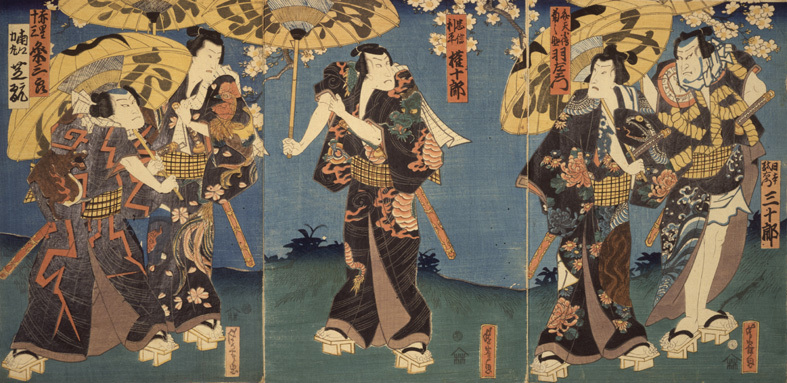資料名 |
Title unknown (“Shiranami Gonin Otoko (Five Notorious Thieves)”, from the kabuki play “Aoto-Zoushi Hana no Nishiki-e”) |
解説 |
Utagawa Yoshitsuru The production date:1862 Five thieves are holding umbrellas. The illustrated scene is one of the highlights of the play that each thief explains his origin and history. The patterns of kimono of Tadanobu Rihei and Nangou Rikimaru are same as the no.51, but there are different patterns as well. In Nihon Daemon’s kimono, magnetic compass and a rope is illustrated. Since he was a head of five men, the items that navigate the other are illustrated. In Benten Kozou’s kimono, the chrysanthemum flowers (Kikunosuke’s “kiku” means chrysanthemum) and a serpent, which is the messenger of the Enoshima Benzaiten Shrine are illustrated. Cherry blossom and cocks are illustrated in Akaboshi Jyuzou, since cock is the bird to tell the morning, which is related to the Akeboshi, the morning star, which is similar to his name Akaboshi. The Dandy Villains: Shiranami Five Thieves Shiranami in Japanese literally means "white waves” and it indicates thief. Shiranami Five Thieves appeare in a kabuki play “Aoto-Zoushi Hana no Nishiki-e (The Glorious Picture Book of Aoto’s Exploits)” and one of the five thieves is Benten Kozou Kikunosuke, who has a connection with Enoshima Island since he worked at the temple of Enoshima when he was a boy. The other thieves are Nihon Daemon, who was the head of a bandit and inspired by the famous thief Ishikawa Goemon, Tadanobu Rihei who had power to appear or disappear freely, a beautiful boy thief Akaboshi Jyuzaburou and rowdy thief Nangou Rikimaru. They were very popular as the dandy antiheros among people since they were not entirely evil, although they stole things from the wealthy people. |
資料番号 |







